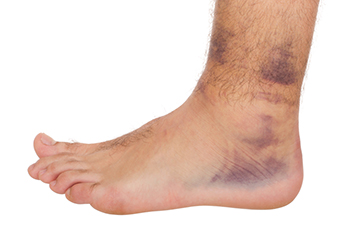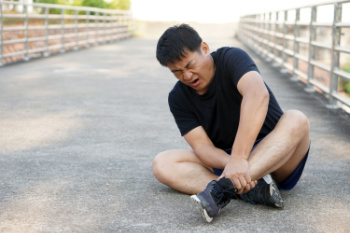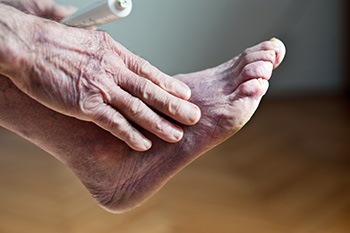Connect With Us
Blog
Items filtered by date: June 2024
Are You Suffering From Nerve Damage?
Three Types of Ankle Sprains

Ankle sprains are common injuries classified into three types based on their degree and severity. A first-degree sprain is the mildest form, involving slight stretching or microscopic tearing of the ligament fibers. Symptoms include mild pain, swelling, and stiffness, with little to no instability in the ankle joint. A second-degree sprain is more severe, characterized by partial tearing of the ligament. This type results in moderate pain, swelling, and bruising, with some difficulty bearing weight and noticeable instability in the ankle. The most severe is a third-degree sprain, where the ligament is completely torn. This causes significant pain, swelling, and bruising, in addition to a substantial loss of function and stability in the ankle. Recovery times vary depending on the severity, with mild sprains healing within a few weeks and severe sprains potentially taking several months. If you have suffered a sprained ankle, it is suggested that you consult a podiatrist who can determine what type of sprain you have endured, and offer correct treatment for it.
Ankle sprains are common but need immediate attention. If you need your feet checked, contact Alice Kim, DPM from 101 Foot and Ankle. Our doctor can provide the care you need to keep you pain-free and on your feet.
How Does an Ankle Sprain Occur?
Ankle sprains take place when the ligaments in your ankle are torn or stretched beyond their limits. There are multiple ways that the ankle can become injured, including twisting or rolling over onto your ankle, putting undue stress on it, or causing trauma to the ankle itself.
What Are the Symptoms?
- Mild to moderate bruising
- Limited mobility
- Swelling
- Discoloration of the skin (depending on severity)
Preventing a Sprain
- Wearing appropriate shoes for the occasion
- Stretching before exercises and sports
- Knowing your limits
Treatment of a Sprain
Treatment of a sprain depends on the severity. Many times, people are told to rest and remain off their feet completely, while others are given an air cast. If the sprain is very severe, surgery may be required.
If you have suffered an ankle sprain previously, you may want to consider additional support such as a brace and regular exercises to strengthen the ankle.
If you have any questions please feel free to contact our office located in Camarillo, CA . We offer the newest diagnostic and treatment technologies for all your foot and ankle needs.
Ankle Pain Can Interfere With Walking
 Ankle pain while walking is a common issue that can arise from various conditions and injuries. This can be difficult just with regular movement, but particularly frustrating when you count walking as an important form of exercise in your life. The ankle is a complex joint connecting the foot to the leg, consisting of bones, ligaments, tendons, and muscles. Pain can result from sprains, strains, fractures, or conditions such as arthritis, tendinitis, and bursitis. Overuse, wearing improper footwear, and sudden changes in physical activity can also contribute to ankle pain. This pain can interfere with walking by causing discomfort, instability, and limited range of motion. Ankle pain may present as a sharp, stabbing sensation or a dull ache, often worsening with weight-bearing activities. Swelling, bruising, and stiffness are common symptoms accompanying the pain. To alleviate ankle pain, rest, compression, and elevation are effective initial treatments. Pain relievers and wearing supportive footwear can also help. Preventative measures include strengthening and stretching exercises, wearing appropriate shoes, and gradually increasing activity levels. If you have persistent or severe ankle pain, it is suggested that you schedule an appointment with a podiatrist for a proper diagnosis and treatment plan so you can walk comfortably again.
Ankle pain while walking is a common issue that can arise from various conditions and injuries. This can be difficult just with regular movement, but particularly frustrating when you count walking as an important form of exercise in your life. The ankle is a complex joint connecting the foot to the leg, consisting of bones, ligaments, tendons, and muscles. Pain can result from sprains, strains, fractures, or conditions such as arthritis, tendinitis, and bursitis. Overuse, wearing improper footwear, and sudden changes in physical activity can also contribute to ankle pain. This pain can interfere with walking by causing discomfort, instability, and limited range of motion. Ankle pain may present as a sharp, stabbing sensation or a dull ache, often worsening with weight-bearing activities. Swelling, bruising, and stiffness are common symptoms accompanying the pain. To alleviate ankle pain, rest, compression, and elevation are effective initial treatments. Pain relievers and wearing supportive footwear can also help. Preventative measures include strengthening and stretching exercises, wearing appropriate shoes, and gradually increasing activity levels. If you have persistent or severe ankle pain, it is suggested that you schedule an appointment with a podiatrist for a proper diagnosis and treatment plan so you can walk comfortably again.
Sports related foot and ankle injuries require proper treatment before players can go back to their regular routines. For more information, contact Alice Kim, DPM of 101 Foot and Ankle. Our doctor can provide the care you need to keep you pain-free and on your feet.
Sports Related Foot and Ankle Injuries
Foot and ankle injuries are a common occurrence when it comes to athletes of any sport. While many athletes dismiss the initial aches and pains, the truth is that ignoring potential foot and ankle injuries can lead to serious problems. As athletes continue to place pressure and strain the area further, a mild injury can turn into something as serious as a rupture and may lead to a permanent disability. There are many factors that contribute to sports related foot and ankle injuries, which include failure to warm up properly, not providing support or wearing bad footwear. Common injuries and conditions athletes face, including:
- Plantar Fasciitis
- Plantar Fasciosis
- Achilles Tendinitis
- Achilles Tendon Rupture
- Ankle Sprains
Sports related injuries are commonly treated using the RICE method. This includes rest, applying ice to the injured area, compression and elevating the ankle. More serious sprains and injuries may require surgery, which could include arthroscopic and reconstructive surgery. Rehabilitation and therapy may also be required in order to get any recovering athlete to become fully functional again. Any unusual aches and pains an athlete sustains must be evaluated by a licensed, reputable medical professional.
If you have any questions please feel free to contact our office located in Camarillo, CA . We offer the newest diagnostic and treatment technologies for all your foot and ankle needs.
Poor Circulation in Your Feet
 Are your feet frequently cold or numb? If so, you may be experiencing poor circulation, a condition that affects blood flow to the feet. Poor circulation can lead to a range of uncomfortable symptoms, including cold feet, numbness, tingling sensations, and sometimes slowly healing wounds. This condition is often caused by underlying health issues such as diabetes, peripheral artery disease, or vascular problems. Ignoring poor circulation can lead to serious complications, including tissue damage and infections. Don't let poor circulation hold you back from enjoying life. If you are experiencing poor circulation in your feet, it is suggested that you schedule an appointment with a podiatrist to discuss treatment options and prevent any further complications or discomfort.
Are your feet frequently cold or numb? If so, you may be experiencing poor circulation, a condition that affects blood flow to the feet. Poor circulation can lead to a range of uncomfortable symptoms, including cold feet, numbness, tingling sensations, and sometimes slowly healing wounds. This condition is often caused by underlying health issues such as diabetes, peripheral artery disease, or vascular problems. Ignoring poor circulation can lead to serious complications, including tissue damage and infections. Don't let poor circulation hold you back from enjoying life. If you are experiencing poor circulation in your feet, it is suggested that you schedule an appointment with a podiatrist to discuss treatment options and prevent any further complications or discomfort.
While poor circulation itself isn’t a condition; it is a symptom of another underlying health condition you may have. If you have any concerns with poor circulation in your feet contact Alice Kim, DPM of 101 Foot and Ankle. Our doctor will treat your foot and ankle needs.
Poor Circulation in the Feet
Peripheral artery disease (PAD) can potentially lead to poor circulation in the lower extremities. PAD is a condition that causes the blood vessels and arteries to narrow. In a linked condition called atherosclerosis, the arteries stiffen up due to a buildup of plaque in the arteries and blood vessels. These two conditions can cause a decrease in the amount of blood that flows to your extremities, therefore resulting in pain.
Symptoms
Some of the most common symptoms of poor circulation are:
- Numbness
- Tingling
- Throbbing or stinging pain in limbs
- Pain
- Muscle Cramps
Treatment for poor circulation often depends on the underlying condition that causes it. Methods for treatment may include insulin for diabetes, special exercise programs, surgery for varicose veins, or compression socks for swollen legs.
As always, see a podiatrist as he or she will assist in finding a regimen that suits you. A podiatrist can also prescribe you any needed medication.
If you have any questions, please feel free to contact our office located in Camarillo, CA . We offer the newest diagnostic and treatment technologies for all your foot care needs.
Foot Care Guidelines for Work

Maintaining foot health at work is essential for overall well-being and safety. Whether enduring long hours on your feet or navigating potential hazards, prioritizing proper foot care can prevent injuries and discomfort. Work-related foot injuries primarily stem from punctures, crushing, sprains, and falls, underscoring the importance of foot safety measures. Neglecting foot care not only heightens injury risks but also contributes to common issues like calluses, ingrown toenails, and fatigue, all of which impairs work performance. Identifying workplace hazards such as prolonged standing, unsuitable flooring and wearing ill-fitted footwear is important for injury prevention. Addressing these concerns through job and workplace design adjustments, including rotation, ergonomic flooring, and protective footwear is essential. Additionally, cultivating good foot care habits like daily washing, toenail trimming, and wearing appropriate socks and footwear is key. Incorporating exercises to alleviate strain during prolonged standing can help. Investing in foot care not only safeguards against injuries but also enhances productivity. If you spend long hours of your work day on your feet, it is suggested that you visit a podiatrist for related foot pain, injuries, or conditions.
While working on the feet, it is important to take the proper care of them. For more information about working on your feet, contact Alice Kim, DPM from 101 Foot and Ankle. Our doctor will treat your foot and ankle needs.
Working on Your Feet
Standing on your feet for long periods of time can cause stress and pain in your feet. Your whole body may experience change in terms of posture, back pain, bunions, callouses and or plantar warts. There are ways to avoid these conditions with proper foot care, smart choices and correct posture.
Positive Changes
Negative heeled shoe – Choosing this shoe type places the heel slightly lower than the ball of the foot. These are great for overall foot health. Find shoes that fit you correctly.
Go barefoot – Our feet were not designed to be enclosed for all hours of the day. Try to periodically expose your feet to air.
Eliminate Pain
Foot Exercises – Performing simple exercises, incorporating yoga and doing stretches are beneficial. This will allow increased blood flow to the area and muscles of the foot.
Achilles tendon – Stretching the foot out flat on the floor will relax the calf muscles and tendon. These exercises can be performed almost anywhere. Make sure you add these exercises to your daily regimen.
With a little bit of this information and knowing more about foot health, you will notice changes. Foot stretches and proper footwear will help with pain and prevent further issues.
If you have any questions please feel free to contact our office located in Camarillo, CA . We offer the newest diagnostic and treatment technologies for all your foot and ankle needs.

